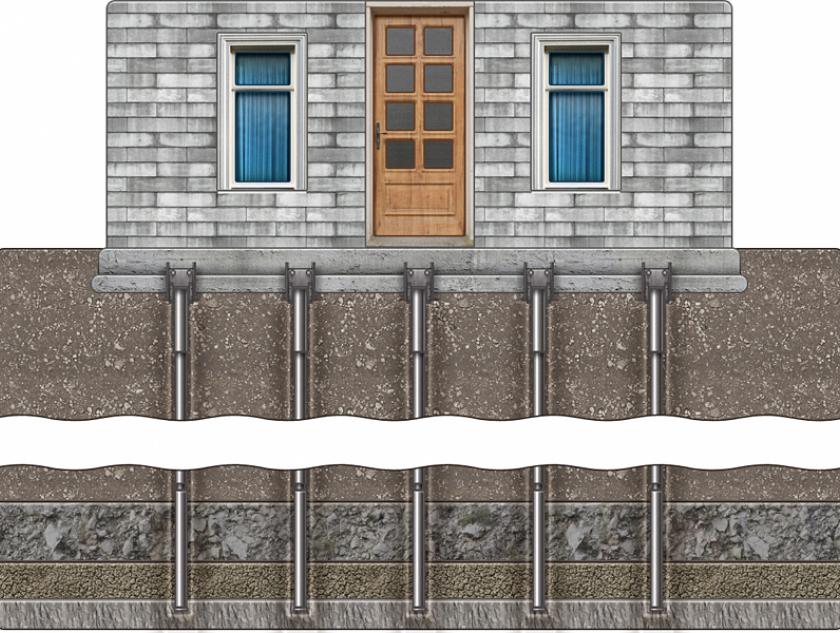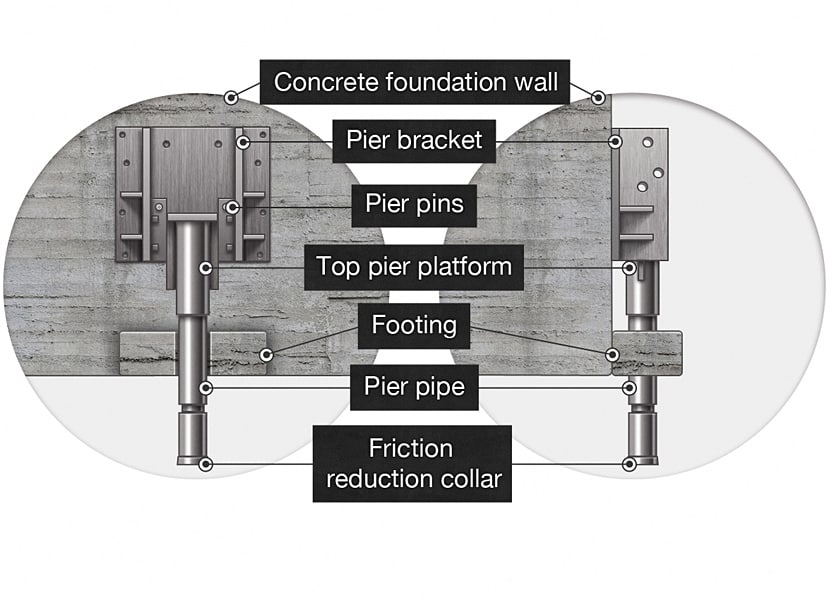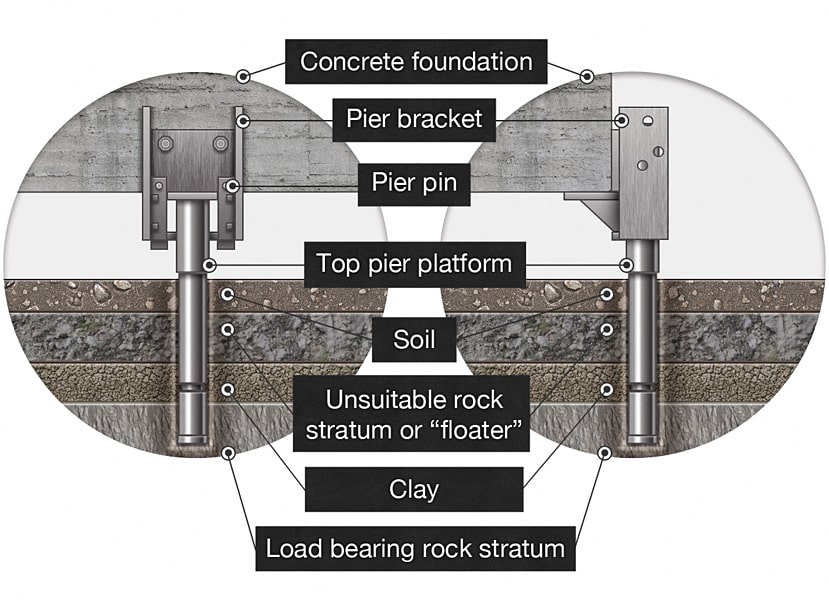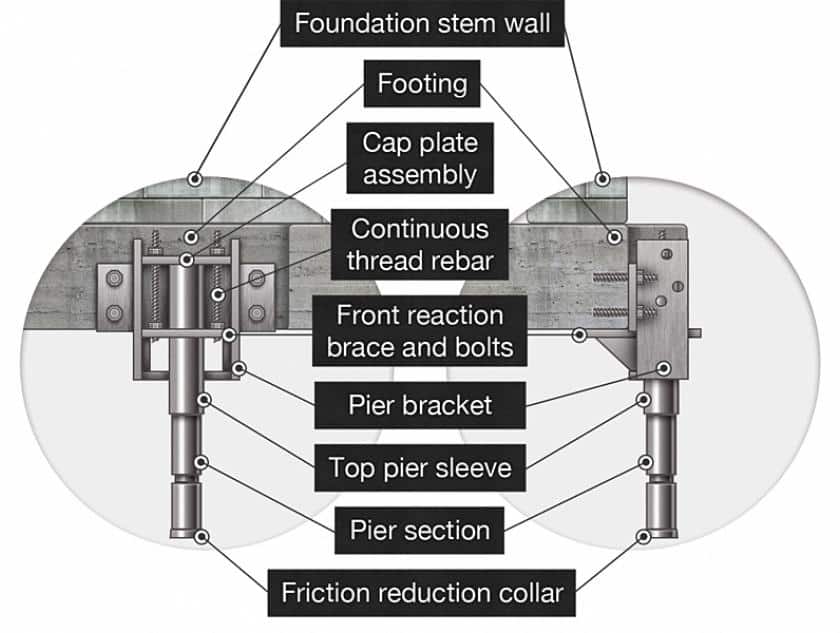Foundation Repair in the Chicagoland Area
Without a firm, structurally sound foundation, your home has no support. Improper foundation support leads to a number of structural defects. Because the foundation supports your entire house, a problem in one area can affect your whole house. Foundation repair and maintenance addressed at the earliest stage ensures the long life of your home and saves you money in the long run. Professional foundation repair can make the difference. Atlas Restoration is a Chicago area foundation leveling and repair specialist, with the experience and equipment to secure your sinking home. Don't let your foundation problems fester and spread. Call us today for a free foundation repair consultation to assess the situation. You may be pleasantly surprised that an early catch is quicker and more economical to repair.
Your home's foundation problems are most likely the result of settling and shifting of the soil under the foundation. A structure's foundation loses its support system as the soil changes or moves. Changes in the soil lead to cracks and defects in the foundation, which in turn adds to your home’s already faulty support system. A number of problems, both visible and unseen, are the result of your home's improper foundation. Atlas Restoration offers foundation leveling pier systems in the Chicago area that can save you money and trouble in the long run.
Common Signs that your Home Needs Foundation Repair
Early identification of foundation problems will prevent more detrimental issues from occurring. Some clear-cut symptoms of potential or existing foundation problems are visible cracks, uneven floors or walls, and uneven beams.
Visible Cracks
Visible cracks in the walls of your home is one of the first and most obvious signs that your home may need foundation repair. You will usually notice these cracks first in the home's basement or lower levels. Professionals know, wall cracks are not a normal occurrence. Cracks occur when the concrete or other material is stressed to the point it cannot withstand. Not all cracks are a sign of danger, but all must be evaluated by a professional to make that determination. Perhaps the foundation has shifted and the walls are no longer being supported on an even surface. The tension on the wall structure created by the foundation shift will cause the wall to crack or break.
Some cracks are merely cosmetic. Let the professionals at Atlas Restoration assess the situation. Atlas Restoration offers affordable foundation concrete crack repair throughout the Chicago area. We perform a complete analysis, determine the cause and extent of the cracking, and let you know our recommendations for dealing with the problem if there is one. Call today to schedule an appointment with an estimator.
Uneven Floors or Walls
Uneven floors or walls are another sign of a failing foundation and may indicate you need to call Atlas for foundation leveling piers for your Chicago home today. Obvious characteristics of uneven floors or walls include:
- Feeling of unevenness when walking across the floor,
- Slanting furniture
- Spaces between walls, spaces between walls and floors, and/or spaces between walls and ceilings.
You may notice these spaces pulling or moving apart over time. Everything in your home should be fit together tightly. Cracks or separations require immediate professional inspection and, possibly, foundation repair. Call Atlas Restoration for a free consultation about our foundation leveling pier systems in Chicago.
Uneven Beams
If you have exposed beams in your home, either in your ceilings or basement, then you can check beams for early signs of defects. Beams should be flush against the ceiling. They should not be bowed or sagging in any way. Beams provide a major support to the home and weak or failing beams can present a very dangerous situation both for you and your home. As failing beams can be a direct result of a flawed foundation, a professional should inspect your home and identify the exact issue, as well as plan the next steps towards solving the problem with foundation repair.
When your foundation is providing improper support to your home, you will start to see signs that, although seemingly minor, may indicate severe problems. If such issues are left unaddressed, your entire home will be weakened by the failing foundation. In certain scenarios, you run the risk of losing your home completely simply because you were not attentive to the warning signs. Foundation repair mitigates that risk.
Brick Cracks
When cracks begin to form on the exterior walls of a home, this can be an early warning sign of foundation issues and the need for foundation repair. While there are ways to temporarily fix these cracks, the larger foundation issues will worsen due to the foundation’s direct relation to the soil around and below the home.
The exterior walls of a home are supported by many materials. Concrete blocks and slabs support the walls and sit on the soil under the ground. As the soil settles under a home, the home’s exterior walls also settle and rotate, causing dangerous shifts in the entire home. Additionally, cracks may appear in the brickwork itself, in the concrete walls or in any of the blocks. These cracks and lines occur because of the rotation of walls and the pressure on other supporting joints in the home. While the cracks may begin small, they rapidly expand, threatening the home’s framework.
Common Causes of Brick Cracks
- Soil Expansion/Contraction
- New Home Settlement
- Weather Events
- Changes in Temperature
- Faulty House Drainage
Cracks in the brickwork of a home can occur at any time. At any stage of a home's life, the home may settle with the soil below. Poor drainage, tree roots and floods are just a few of the factors which can cause the foundation soil to settle further, regardless of the age of your home.
Filling cracks is a temporary solution to a potentially permanent problem. In order for your crack issues to be permanently fixed, your brickwork's sealer and filler must be dug out and removed prior to permanent repair. Although hiring rebuilders to rebuild exterior problems may seem like an effective temporary solution, the larger problems will likely return, particularly if the cracks are related to the soil underneath your home. While repairs to walls and exterior brickwork is a good idea, the base of the home must be fixed first.
Interior Wall Cracks
If the foundation of your home is settling due to age or shifting ground conditions, it can result in cracks in the interior walls. This can be caused by several factors. When your house was built, factors such as compression stress, soil shrinkage, slippage, and concrete shrinkage were taken into account. But over time, especially many years, those conditions can change both from changes within the earth and outside influences such as weather, excavation, building in the area, and general deterioration of the building materials. As initial cracks in the interior walls of a home seem like a minor issue, the variation of types and severity of cracks are not very obvious. Ignoring the changes in these cracks over time—which most often occur as the house settles—results in the development of serious, potentially dangerous cracks.
Common Causes of Interior Wall Cracks
- Shrinkage of Natural Drywall
- Poor or Improper Foundation Construction
- Changes in Temperature
- Settlement of New Home
- Soil Expansion/Contraction
Wall gaps and cracks can be either vertical or horizontal in appearance. Important to understand is that horizontal cracks are not as troubling as vertical cracks. When a house is constructed, during the drying process after plastering, some wall gaps may appear due to a loss of moisture. The drying of the surface may result in horizontal gaps. The horizontal interior wall cracks, which appear in the plaster, are usually not very dangerous–they are often symptoms of a cosmetic, rather than structural issues. Vertical cracks, however, which appear when there is any movement in the wall, may be a sign of something more dangerous and in need of immediate attention. If timely attention is not given to vertical cracks, these cracks may become bigger and more menacing, as they will spread into other areas of the walls. Foundation stabilization is crucial to ensuring that the interior wall cracks do not expand. Professionally repairing and reinforcing the foundations will ensure that these structural flaws and holes are mended. Gaps can be dealt with in part through the use of waterproofing products. These products can be used both on external and internal surfaces. Patching tape, often used with putty, is another way to fill and repair wide gaps. The use of foam is also suggested for filling larger gaps.
These repairing techniques, though they provide short-term relief of wall gap and crack problems, are merely a temporary solution to a larger, more pressing problem. If your home experiences any of the problems addressed above, your smartest next step would be to seek out a foundation repair company that deals with soil and foundation concerns. A company such as Atlas Restoration will provide you with an accurate work estimate based on a number factors, including the size of your home, and the severity of the problems related to your home’s foundation, gaps, and cracks.
Leaning Chimney
There are several reasons why your home may have a leaning chimney. The general foundation of a house depends on the earth around it to keep it all solid and in place. While a foundation can be built very precisely, one cannot compensate for the slow but constantly varying changes to the soil and ground around the foundation that occur over time.
Many soils, for example, expand and contract due to differing conditions. If saturated with water, the clay in soil weakens, which in turn causes the foundation to sink into the ground. Foundation shifts may also be caused by the presence of trees and big bushes in home's vicinity. Your home's foundation may also be affected by an excess amount of drainage from trees. Furthermore, improper drainage can cause structural settlement.
Common Causes of a Leaning Chimney
- Types of Surrounding Soil
- Soil Expansion/Contraction
- Weak “Elastic” Soil
- Landscaping Proximity
- Poor Drainage in Vicinity of Foundation
Another main contributor to your home's settlement is backfilled soil, which is regularly used in building construction. Improper concentration levels of this compacted soil can mean damaging consequences to your home's foundation.
The chimney is typically the heaviest part of your house. When soil problems like the ones listed above occur, the chimney usually shows the first signs of shifting. When a chimney submerges it begins to lean away from the house. This effect, known as 'settling', can have other serious implications, not least of which is a severe drop in your home's value. Once these signs appear, the problem most often worsens.
Temporary fixes like strapping are rarely effective solutions. Such a quick fix usually merely postpones, rather than prevents reoccurrence of the problem. Although many homeowners attempt to repair chimney problems on their own, only professionals can tackle the core of each problem and will most effectively ensure that the solution is a lasting one. Atlas Restoration is one company that will identify your home's chimney problems, provide a free consultation, and will provide successful repair.
Sticking Windows and Doors
Some homeowners will notice that their windows are cracking along the caulking area. These may be splits or cracks that often begin small, but over a short time may quickly spread. Cracks and gaps along windows and door frames can be a sign of a more serious problem affecting a larger area of your house. Cracking around the brick close to a window may also cause the windows to get stuck. While the glass and frame may have been installed using proper measurements, over time, if the house has changed in anyway, then the frame and glass may get jammed.
A door that will not close properly and needs a stronger push to open often indicates a problem with your home. Some doors will get stuck while trying to be opened or may have a hard time closing; small cracks, openings or gaps around the border of the frame might indicate a separation.
Gaps in doors and windows may be the result of shifts in the home and early indicators that the foundation is shifting and changing. Homeowners should inspect their house once a year to check for any signs of a more serious issue. Detecting problems early and taking care of them professionally is the best way to ensure that the issues remain minor. Fixing the issue below the foundation by hiring a foundation repair company who deals with soil and foundation concerns is your best solution. Atlas Restoration will provide you with a full evaluation of your gap problem, including identification of problems and plans for repairing the structure. Upon inspection, an Atlas Restoration representative will provide you with an estimate based on the size of your home, exterior factors and the severity of the problem.





Are these your symptoms?
- Visible Cracks
- Uneven Floors or Walls
- Uneven Beams
- Brick Cracks
- Interior Wall Cracks
- Leaning Chimney
- Sticking Windows and Doors
The Solution for Foundation Repair: Atlas Piers
For years, Atlas has relied on our own Atlas Piers for foundation repair in Chicago. Before installing Atlas Piers, our first step is to excavate and expose the structure’s footing. Following excavation, we create a new support of the structure by installing ATLAS PIERS® on firm bearing stratum or bedrock. After piers are carefully positioned, your home's load is transferred onto its new foundation pier system. Following this transfer, a system of hydraulic rams is used to lift your house to its original elevation.
Benefits of Atlas Piers
- Fast Installation
- Minimal Site Disturbance
- Easy Installation in Limited Access Areas
- On-Site Load Test Capability
- Immediate Loading
- All-Weather Installation
- Exceptional Strength
- No Vibration
- No Soil Removal
- Highly Economical
- Bearing and Anchoring Capabilities
- Reverses the Damaging Effects of Foundation Settling
Every year, nearly a quarter-million homeowners are faced with sinking foundations, cracked and buckled walls, and uneven floors. Homes situated on insecure soils settle when their foundations lack proper drainage or when they are subjected to extreme moisture. A shifting foundation will create structural damage and will decrease the value of your home.
Stabilize your Home's Foundation
By transferring the weight of your home to solid, stable soil, which may only exist several layers below the existing foundation, the Atlas Restoration team provides a permanent solution to your home's settling or sinking foundation. Installation of Altas Piers prevents these issues from becoming worse, provides renewed stability, and, in nearly all cases, immediately reverses the structural damage.
As a homeowner, your primary foundation concern should be the quality and durability of the components used in your home's piering system, as well as knowledge of installation providers. Your Atlas installer is a leading contractor in resistance piering, which means that your home's foundation will be repaired correctly the first time.
Take Steps to Protect Your Largest Investment - Call Today for Chicago Area Foundation Repair
First, an Atlas steel pier is driven into the ground, providing your home's foundation with load bearing support. Effective and exact load tests are conducted on-site to evaluate the capacity of every pier. This ensures that after installation, the load will be supported properly and immediately. Next, your home's foundation is hydraulically restored to the correct elevation.
The steel piers are then driven into connected sections, using the weight and structural makeup of your home to load the piles to a stable bearing stratum. Resistance piers are hydraulically driven, high-strength steel, tubular, end-bearing piles. The pile sizes vary in diameter (from 2 2/8" to 4 1/2") and in thickness of steel and transfer brackets to cope with a wide range of support and load conditions. There is a parallel correlation between drive force and pile capacity. During installation, drive force is regularly measured to a predetermined range with a 1.5-2X safety factor. The drive force measures the end bearing capacity of the soil, rock, and pile under your home. The harder the soil is, the greater the drive force needed. The predetermined capacity is acquired from estimating and analyzing your home's weight (live loads, dead loads, and soil loads) and the structural strength of your home's various support components. Pier spacing is determined by a number of influences: the weight of your home, capacity of selected pile, soil type, and structural strength of your home's foundation to determine span limits. By measuring drive force the capacity of the soil is measured and the pier is repeatedly tested.
Most importantly, the Atlas Restoration team will ensure that your home’s foundation repair problem is solved immediately and correctly. Atlas Restoration has an experienced, skilled team that knows how to fix a sinking foundation in any situation.
